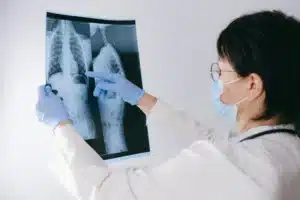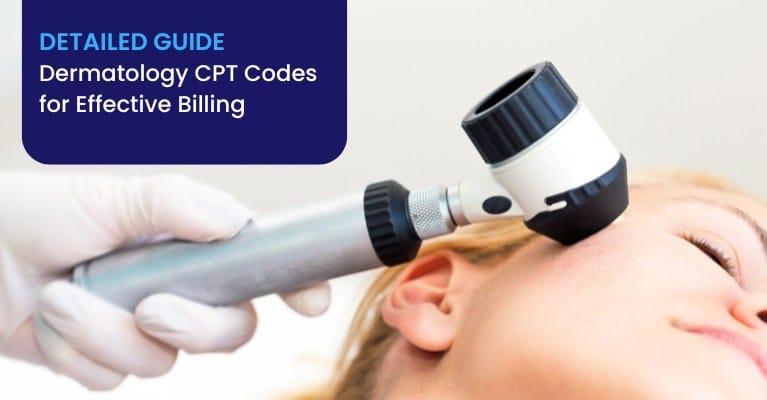
Menu

Could you have outsourced yourself with rejected claims and delayed payments because of coding errors? Many healthcare professionals experience this issue. Errors in Dermatology CPT Codes can significantly impact your practice’s revenue, complicating what should be simple billing processes.
Dermatology CPT codes are crucial for accurate medical billing, ensuring healthcare providers receive appropriate reimbursement for services rendered. They help standardize billing across practices, reducing confusion and errors. Accurate coding minimizes claim rejections and denials, optimizing the revenue cycle.
Our main goal is to help you improve your billing processes, increase claim accuracy, and enhance your practice’s financial health.
Understanding the correct CPT codes is essential for dermatologists and billing professionals. It ensures accurate billing, facilitates timely insurance reimbursement, and helps to keep patient records efficiently.
Evaluation and Management (E/M) codes are important for dermatology practices, reflecting the complexity and time spent during patient consultations. They range from 99201 to 99215 listed below given table:
| CPT Code | Description | Common Use Cases |
| 99201 | Office or other outpatient visit, new patient | For evaluating and managing a new patient, minimal complexity. |
| 99202 | Office or other outpatient visit, new patient | To evaluate and manage a new patient, low complexity. |
| 99203 | Office or other outpatient visit, new patient | For detailed evaluations for new patients, moderate complexity. |
| 99204 | Office or other outpatient visit, new patient | For comprehensive evaluations, new patients, moderate to high complexity. |
| 99205 | Office or other outpatient visit, new patient | For extensive evaluations of new patients with high complexity. |
| 99211 | Office or another outpatient visit established the patient | For minimal management of an established patient. |
| 99212 | Office or another outpatient visit established the patient | For managing an established patient, low complexity. |
| 99213 | Office or another outpatient visit established the patient | For managing an established patient, moderate complexity. |
| 99214 | Office or another outpatient visit established the patient | For detailed management of an established patient. |
| 99215 | Office or another outpatient visit established the patient | For extensive management of an established patient with high complexity. |
Biopsy procedures are core to dermatological diagnostics, with specific codes such as 11100 for a single lesion biopsy and 11101 for each additional lesion. These codes ensure detailed billing for each procedure, facilitating accurate reimbursement.
| CPT Code | Description | Common Use Cases |
| 17000 | Destruction of premalignant lesions | Typically used for the first lesion, like actinic keratoses. |
| 17003 | Destruction of additional premalignant lesions | Use for each additional lesion after the first, up to 14. |
| 17004 | Destruction of extensive premalignant lesions | Used for treating 15 or more lesions, typically in extensive cases. |
| 11646 | Excision of malignant lesions with margins | Used for excision on the face, ears, eyelids, nose, and lips. |
| 96910 | Photochemotherapy with UV B | Used for treating skin conditions such as psoriasis. |
| 96900 | Actinotherapy (UV light treatment) | Often used for broader UV light treatments for skin disorders. |
| 11100 | Biopsy of skin, single lesion | Diagnostic biopsy for one lesion. |
| 11101 | Biopsy of skin, each additional lesion | Used for each additional lesion biopsied during the same session. |
At times the correct coding for various dermatological treatments is crucial for ensuring proper billing and compliance. Current Procedural Terminology (CPT) codes are used for common dermatological procedures, enhancing billing accuracy and facilitating better insurance reimbursements.
Getting to know precise dermatological procedures in medical billing is essential for receiving appropriate compensation and maintaining detailed patient records. CPT code 11600 is typically employed for the removal of malignant lesions on the skin, ensuring targeted treatment and documentation. For benign lesion excision, CPT code 11400 is used, covering procedures on the trunk, arms, or legs, which are the most common areas requiring this type of intervention. Cryotherapy, an effective treatment for removing warts and other skin lesions, utilizes codes like CPT 17000 for the first lesion, with additional lesions addressed by subsequent codes, reflecting the session’s complexity and resources used.
Accurate coding is more important for specialized treatments such as phototherapy and laser therapies, which require precise documentation to align with insurance and regulatory standards. CPT code 96910 is crucial for phototherapy involving UV light, addressing skin conditions such as psoriasis and eczema. Similarly, CPT codes 96920 and 96921 detail the use of laser treatment for inflammatory skin diseases, highlighting the treatment’s specificity and area coverage. These codes help ensure that such advanced therapies are correctly logged for billing and compliance, showcasing the need for meticulous attention to the coding process.
There might be outsourcing for dermatology practices to ensure efficient billing and reimbursement. Here we discuss, how to refine coding accuracy with a focus on specific, often complex, dermatology CPT codes such as CPT code 11406 for excision of benign lesions and CPT 17004 for the destruction of extensive premalignant lesions.
Utilize Advanced Codes Correctly: For example, CPT code 11406 involves excising benign lesions with specific margins, and CPT 17004 for extensive premalignant lesions, which requires accurate measurement documentation.
Documentation Requirements: Ensure that the size, location, and number of lesions treated are documented to support the use of detailed codes.
Example Scenario: A dermatologist performs multiple benign lesion excisions on a patient’s back; using CPT code 11406, documentation must reflect each lesion’s diameter and precise location.
It is essential to understand the complexities of dermatology billing by identifying and resolving common coding errors, enhancing both compliance and reimbursement rates.
Identify Common Errors: Common issues include undercoding or overcoding, which can lead to claim rejections or audits.
Practical Solutions: Implement regular training sessions on the latest dermatology CPT codes and updates.
Utilize Resources: Employ checklists to verify all necessary documentation is complete and correct before claim submission, reducing the risk of errors.
Audit Regularly: Schedule periodic internal or external audits to ensure coding practices meet compliance standards and identify areas for improvement.
Accurately navigating Dermatology CPT codes is paramount for effective medical billing and overall financial health of your practice. This guide not only simplifies complex coding but also ensures you capture every service rendered, leading to well-deserved reimbursements. Stay diligent, continuously educate your team, and employ regular audits to keep your billing processes error-free. Your practice’s success hinges on these details, ensuring stability and patient satisfaction. Remember, every correct code counts towards a healthier practice.
1.What are Dermatology CPT codes?
Dermatology CPT codes are numerical labels used for billing and documenting medical services in dermatology.
2.Why is accurate coding important in dermatology?
Accurate coding ensures correct billing, reduces claim denials, and secures appropriate reimbursement for services.
3.How can I avoid common coding errors in dermatology?
Regular training, using checklists, and conducting coding audits can help minimize coding errors.
4.What CPT code is used for the biopsy of a single skin lesion?
CPT code 11100 is designated for the biopsy of a single skin lesion.
5.Can CPT code 96910 be used for conditions other than psoriasis?
CPT code 96910 is also used for other skin conditions treated with phototherapy, not just psoriasis.



